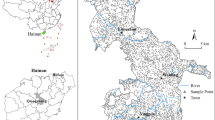Abstract
To meet the goal of sustainable development, many large steel enterprises in China have been relocated, leaving serious polycyclic aromatic hydrocarbon (PAH) pollution problems at the abandoned sites. In this study, the spatial distribution and potential health risks of PAHs in soils of a large steel enterprise in East China were studied. The total concentrations of 16 PAHs ranged from 93.96 to2.61E + 05 μg/kg. A total of 54.84% of the samples reached the level of severe pollution, with coking plants and iron works showing much more serious problems than other areas. The contribution levels of PAHs with high molecular weights were high, especially those of 4-ring PAHs. The toxic equivalent concentrations exceeded the values recommended by the Canadian guide. The average carcinogenic risk value of the whole region was greater than 10–6, indicating high carcinogenic risk. The above assessment indicates that the area must be remediated before further development occurs.

Similar content being viewed by others
References
Cao W, Geng S, Zou J, Wang Y, Guo Y, Zhu Y, Dou J (2020) Post relocation of industrial sites for decades: Ascertain sources and human risk assessment of soil polycyclic aromatic hydrocarbons. Ecotoxicol Environ Saf 198:110646
Ferrara L, Trifuoggi M, Toscanesi M, Donadio C, Barra D, Aiello G, Arienzo M (2020) Source identification and eco-risk assessment of polycyclic aromatic hydrocarbons in the sediments of seawaters facing the former steel plant ILVA, Naples, Italy. Reg Stud Mar Sci 35:101097
Gao C, Gao W, Song K, Na H, Tian F, Zhang S (2019) Spatial and temporal dynamics of air-pollutant emission inventory of steel industry in China: a bottom-up approach. Resour Conserv Recy 143:184–200
Khanal R, Furumai H, Nakajima F, Yoshimura C (2018) Carcinogenic profile, toxicity and source apportionment of polycyclic aromatic hydrocarbons accumulated from urban road dust in Tokyo, Japan. Ecotox Environ Safe 165:440–449
Li F, Guo S, Hartog N (2012) Electro kinetics-enhanced biodegradation of heavy polycyclic aromatic hydrocarbons in soil around iron and steel industries. Electrochim Acta 85:228–234
Li Y, Duan X (2015) Polycyclic aromatic hydrocarbons in sediments of China Sea. Environ Sci Pollut R 22:15432–15442
Maliszewska-Kordybach B (1996) Polycyclic aromatic hydrocarbons in agricultural soils in Poland: preliminary proposals for criteria to evaluate the level of soil contamination. Appl Geochem 11:121–127
Mihankhah T, Saeedi M, Karbassi A (2020) Contamination and cancer risk assessment of polycyclic aromatic hydrocarbons (PAHs) in urban dust from different land-uses in the most populated city of Iran. Ecotox Environ Safe 187:109838
Ministry of Ecology and Environment, China (2016) Soil and Sediment-Determination of polycyclic aromatic hydrocarbon by Gas chromatography-Mass Spectrometry Method, HJ 805-2016. (in Chinese)
Ministry of Ecology and Environment, China (2018) Soil environmental quality Risk control standard for soil contamination of development land, GB36600—2018. (in Chinese)
Ning XA, Lin MQ, Shen LZ, Zhang JH, Wang JY, Wang YJ, Yang ZY, Liu JY (2014) Levels, composition profiles and risk assessment of polycyclic aromatic hydrocarbons (PAHs) in sludge from ten textile dyeing plants. Environ Res 132:112–118
Peng C, Chen W, Liao X, Wang M, Ouyang Z, Jiao W, Bai Y (2011) Polycyclic aromatic hydrocarbons in urban soils of Beijing: status, sources, distribution and potential risk. Environ Pollut 159:802–808
Qu Y, Gong Y, Ma J, Wei H, Liu Q, Liu L, Wu H, Yang S, Chen Y (2020) Potential sources, influencing factors, and health risks of polycyclic aromatic hydrocarbons (PAHs) in the surface soil of urban parks in Beijing. China Environ Pollut 260:114016
Thuy CN, Loganathan P, Tien VN, Vigneswaran S, Kandasamy J, Slee D, Stevenson G, Naidu R (2014) Polycyclic aromatic hydrocarbons in road-deposited sediments, water sediments, and soils in Sydney, Australia: comparisons of concentration distribution, sources and potential toxicity. Ecotox Environ Safe 104:339–348
Wang W, Ding X, Turap Y, Tursun Y, Abulizi A, Wang X, Shao L, Talifu D, An J, Zhang X, Zhang Y, Liu H (2020) Distribution, sources, risks, and vitro DNA oxidative damage of PM2.5-bound atmospheric polycyclic aromatic hydrocarbons in Urumqi, NW China. Sci Total Environ 139518.
Williams ES, Mahler BJ, Van Metre PC (2013) Cancer risk from incidental ingestion exposures to pahs associated with coal-tar-sealed pavement. Environ Sci Technol 47:1101–1109
Wu B, Guo S, Wang J (2021) Assessment of the human health risk of polycyclic aromatic hydrocarbons in soils from areas of crude oil exploitation. Environ Res 193:110617
Acknowledgements
This study was supported by the National Key Research and Development Program of China (2018YFF0213404), the Major Basic Research Projects of the Shandong Natural Science Foundation, China (ZR2018ZC2362), the Shandong Province Key Research and Development Project (2019GSF109097), and the National Science Foundation of China (42007112).
Author information
Authors and Affiliations
Contributions
Conceptualization: Meng Xie; Formal analysis and investigation: Meng Xie; Writing—original draft preparation: Meng Xie; Methodology: Shouwen Zhang; Resources: Shouwen Zhang; Funding acquisition: Zhaojie Cui; Supervision: Zhaojie Cui; Writing—review and editing: Xiufeng Cao.
Corresponding authors
Additional information
Publisher's Note
Springer Nature remains neutral with regard to jurisdictional claims in published maps and institutional affiliations.
Supplementary Information
Below is the link to the electronic supplementary material.
Rights and permissions
About this article
Cite this article
Xie, M., Zhang, S., Cui, Z. et al. Distribution Characteristics and Risk Assessment of Polycyclic Aromatic Hydrocarbons in Soils of a Steel Enterprise in East China. Bull Environ Contam Toxicol 106, 873–877 (2021). https://doi.org/10.1007/s00128-021-03193-9
Received:
Accepted:
Published:
Issue Date:
DOI: https://doi.org/10.1007/s00128-021-03193-9




